







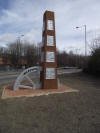
|
 |

Click to return to front page |
By Frank Sharman
BILSTON TOWN DURING THE 18TH CENTURY
Industries spread out
over all the old manorial lands, wreaking havoc with the landscape.
Agriculture was not entirely excluded but, by the second half of the
18th century, it took place in the gaps between mining
and manufacturing – and these gaps gradually became fewer though
they did not disappear entirely until late in the 20th
century.
Of this period Dr. Rowlands
says of Bilston: “Here in the course of the hundred years before
1760 new trades, new men, new wealth and a new way of life were
established. … In 1666 there were only 46 householders paying tax
and 61 certified as exempt. Thirty years later in 1695 a list of
the population for taxation purposes names 1006 men and women and
children, including a high proportion of young single men. … In
1767 a return estimated the population of [Bilston] chapelry as
‘about 5,000’, that is, about ten times that indicated in the hearth
tax return of a hundred years before”. Joseph Price, writing of a
time about 1780, says “The principal Trades at this time carried on
in Bilston were the Buckle and Chape, the Japan, the Enamel and the
Metal Box, vast quantities of which were Manufactured here”.
 |
Cut steel buckle and chape.
The chape is the operative part at the back with the
prongs. Typically the chape was made in Bilston
and the ring (the part at the front) was made in
Wolverhampton. |
Clearly the industrial
revolution had hit Bilston and by 1760 the town and its people would
have been largely unrecognisable as the town and its people in
1660. What is not clear is why this occurred. Geographical and
geological determinism never were satisfactory explanations and
their shortcomings are illustrated by the contrast Dr. Rowlands
shows between Bilston and Sedgley, a place similarly situated but
where the course of development was quite different.
In 1727 Bilston’s
communications had been somewhat improved by the passing of the
first Turnpike Act to include any road in the area. Eventually most
of the roads out of the town were turnpiked and the town was
surrounded by toll gates. Under an Act of 1776 the road from
Bilston to Wednesbury was created, the road originally having gone
via Darlaston. The point where what is now Oxford Street crossed
the brook was almost certainly a ford; eventually it was crossed by
Goddard’s Bridge, the original date of which is unknown but the
records show its being repaired in 1670.
Bilston lay on the
Holyhead Road and was certainly a staging post on the coaching
route, though probably not a major coaching centre, that role being
taken, locally, by Wolverhampton.
| Most road traffic was in the
form of mules, horses, wagons and carts. The
romantic heyday of the stage coach was quite short
lived, from the end of the eighteenth century to the
coming of the railways.
The roads themselves were
probably not as bad as we tend to think - they actually
worked. |
 |
But industry would have been
given a great boost by the coming of the canal in 1767, making it
easier and far cheaper to distribute (and receive) raw materials and
finished goods. Joseph Price wrote that the canal “had been of vast
importance to the Proprietors of Lands and Mines in this Town and
the Neighbourhood: Blast Furnaces for the smelting of Iron began to
be erected about this time in this Township, the first of which was
that belonging to the late John Wilkinson Esq., near the Fireholes,
and called the Old Furnaces; another was erected by the same
Gentleman close to the canal at Upper Bradley, and one at the
Western extremity of the Township by the late John Bickley Esq,”.
There were other
improvements to the town. The Rev. Ames records a new burial ground
being created; some of the town ways being paved; and, partly at the
cost of Ames himself, a Poor House was established. This workhouse
was established in 1700 and stood in Workhouse Fold in the town
centre.
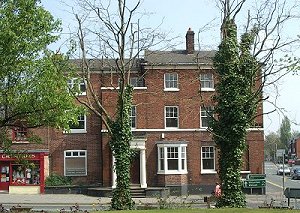 |
The Ivy House today seen from
the new burial ground. This house is one of the
few survivors of the many Georgian houses built in
Bilston, reflecting the increasing wealth of the town. |
The population was greatly
increasing. Population figures given by Lawley (which he got from
census returns and, before that, by guessing) are:
| 1650 |
500 |
| 1728 |
1000 |
| 1780 |
3000 |
| 1821 |
12,003 |
| 1831 |
14,492 |
| 1841 |
24,420 |
| 1861 |
24,762 |
| 1871 |
26,400 |
(Joseph Price works out a
population of 3,875 for 1771 which is significantly more than one
would have expected from Lawley's figures. But the general trend is
unaffected - the increase in population accelerates from the end of
the 18th century).
These figures show the
enormous increase in population and they suggest the problems that
brought with it. They also reflect the changing economic climate,
the 19th century being particularly prone to periods of
boom and bust. Lawley says that since 1871 (and he writes in the
1890s) the population has decreased to a little over 24,000, because
the coal mining industry was almost at an end and the iron trade was
in deep recession.
In the 18th
century the town was already beginning to show some of the drawbacks
of industrialisation, overcrowding and poor drainage and sanitation.
In 1728 and 1729 an “epidemical distemper” of an unknown sort
caused a great mortality, with 172 burials being recorded in just
two years from a population of about 1,000. In 1756 and 1757 they
were other epidemics, this time of “putrid fever” or “flux of
fever”. In 6 months this took off 51 people.
The parish registers show
that the town had a Constable but his powers were distinctly
limited. In 1694 the registers first record the installation of a
pair of stocks, but these were certainly not the first. They had to
be repaired from time to time and replaced completely in 1764. The
stocks were in Lich Gates, where they stayed until moved to the
headquarters of the new Peelers when they were established.
How badly you
were pelted with rubbish depended on what the locals
thought of you and your offence. The main purpose
of stocks and pillories was to humiliate the offender.
| A typical set of stocks.
There would have been a bench behind for the miscreant
to sit on. (A pillory was a similar structure with
holes for the arms and the head).There
was also a gibbet, presumably set up where Gibbet Lane met the
Wolverhampton Road
|
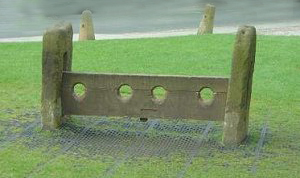 |
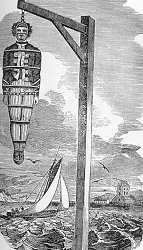 |
It should
be noted that the presence of a gibbet is not evidence
of sentences being executed and criminals hanged in
Bilston. It was only after you had been hanged
(probably in Stafford) that your body was hung, in a
metal cage, upon a gibbet, preferably near to where you
came from or committed the foul deed. The image
shows a seaside gibbet, probably displaying a pirate or
mutineer. "Shepherding the moonlit sheep"
was a warning to others as
much as a post mortem humiliation. |
In 1719 a new house was
provided for the curate of St. Leonard’s. The Rev. Ames moved in on
the 9th May. The house stood “on the Church Street side
of the churchyard, opposite the entrance to the grounds of Pipe Hall
Hotel”. It moved from there in 1820, to a new building next to the
church near the Mount Pleasant junction. The new house of 1719 was
said to be near the school. Presumably this was a church school,
possibly just a Sunday school. There seems to be little other
reference to education in Bilston up to this time but doubtless
there were a number of private schools and dame schools.
The town was not without
entertainment. The ceremony of beating the bounds continued until
1827. The Gunpowder Plot was celebrated each 5th
November, as was the Restoration of Charles 2nd each 29th
May. Both occasions brought forth bonfires, fireworks and a good
deal of drinking.
On the 11th April
1754 the Swedish industrial spy, Rheinhold Angerstein, visited the
town and he reported:
“Bilston is a town that
consists mainly of factories for metal boxes and other and
punched work which comes under the heading ‘toy ware’ or
‘Quincaillerie’ [small metal goods]. I viewed here one or two
of these works, where the people were occupied with the making
of paste gems and enamelled work to be incorporated into boxes
and watch chains and with the filing and carving of mother of
pearl. Of this ware I was shown a set of tea caddies and boxes,
which cost 60 guineas. For purchase of half-a-dozen or a dozen
of these items a discount of 15 per cent is allowed”.
“In one farmhouse
between Bilston and Wolverhampton there was a factory for making
snuff-boxes and other enamelled work, where a large number of
women were employed in preparing the enamel, dipping the copper
sheets and painting. They were also occupied in firing and
tempering the enamel … Later on I saw a factory making the same
things in Wednesbury and there are also a large number of them
in Bilston. The boxes fetch good prices when sold, according to
the quality of the painting. A discount of 15 per cent is
allowed if one takes a dozen or more”.
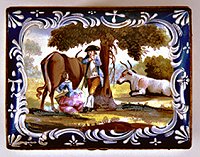 |
Handpainted enamel boxes like
this were typical of Bilston wares. It was mostly
a cottage industry but some larger works appeared.
Image by permission of and
copyright of Wolverhampton City Council and not to be
reproduced without their permission. |
In June 1754 Angerstein was
back again and making a new report:
“On the way [from
Wolverhampton] to Wednesbury and Birmingham I went through
Bilston, which manufactures many kinds of wares in non-ferrous
metals such as pinchbeck, as well as engraved and turned
mother-of-pearl for boxes and watch chains, buttons and all
sorts of similar articles. Here are also workshops for
enamelled boxes made of copper sheets, which are stamped in dies
of various shapes. Lacquered boxes of sheets are also made
around here. All these wares are sold at high prices, the
actual figured depending on the pattern and novelty-value of
inventiveness displayed by the painting, enamelling or
lacquering.”
A japanned tray. Bilston
mainly japanned on plate metal, not papier mache.
The town made vast numbers of blank trays, many of which
were sold on to Wolverhampton japanners.
Image by permission of and
copyright of Wolverhampton City Council and not to be
reproduced without their permission. |
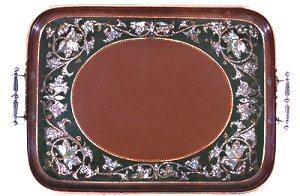 |
Angerstein was only
interested in industrial production, but Lawley, Price and Page all
quote a description of Bilston, made in 1790, by an American who
passed through the village and who provides a more general picture.
None of the writers who quotes this passage says where this
description originated but, as they all used it, it might as well
appear here.
"It is one of the largest villages in England, containing
more than 1,000 houses. It is situate on a rising ground on the
old Watling Street Road, from London to Holyhead, and the
navigable canal (not long opened) from Birmingham to London.
The Worcestershire and Staffordshire Canal also passes close by
it, by which means it enjoys a constant and ready means of
communication with the metropolis, the western parts and the
numerous manufacturing towns between them. Some thirty coaches
pass through here daily, and the London coach weekly. It is of
ancient date, probably going back as far as Saxon times. The low
many gabled, half-timbered, octagonal shaped houses of the Tudor
age, are dotted about here and there, and inhabited by the
gentry, and stand without any regard for regularity. The
principle manufactures consist chiefly of Japanned goods,
buckle-chapes, which are wrought to great perfection, iron
screws, and recently erected iron furnaces and foundries, worked
by the steam engines. …
"The Chapel is a modern edifice, though built on the
foundations of an ancient structure. It is covered with slate,
has a square tower of brick, and contains six bells. There are
likewise a dissenting chapel and charity school. The principle
Inn is the Bull, and the population, recently much increased is
4,800".
By 1800 the whole nature of
the town had changed, from a modest agricultural village to a
stirring giant of industry. As we will see the town now did not
have any governmental structures in place to deal with this
radically changed situation. By this time the manorial courts had
largely fallen into disuse, only operating – and probably not all
that well – to register dealings in copyhold land. The magistrates,
at Petty and Quarter Sessions, continued to play an important role,
but mainly limited to dealing with such crimes as came before them
from a town which lacked a police force.
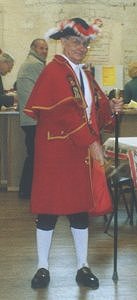 |
Wolverhampton's town crier,
Percy Simmons. The traditional dress of the town
crier is a left over of the 18th century. Its
colour and style is not prescribed anywhere and, these
days, is left largely to the whim of the individual
crier. Although a crier was also known as a
bellman, even the bell was not a necessity - a horn
might be used instead.
After making a proclamation the
crier would usually post copies of it around town. Criers fell out of use with the the widespread use of
printing, the development of newspapers and the coming
of radio and television. But public proclamations
of events such as the death of a monarch continued to be
cried but they were often read by the Town Clerk. |
Most of what had been done
by way of governing the town, had been done by the Vestry of St.
Leonard’s – in effect a committee of the chief men of the town – but
the Vestry had very limited powers to deal with the new challenges.
Everything that was done was done by what were, in effect, the
voluntary efforts of those with an interest in improving the town.
Dr. Rowlands, referring to the “new men”, including the enamellers
Dovey Hawksford and John Bickley, says: “From about 1730 it was
these men who took the lead in local affairs. They continued to
fight for independence from the mother church of Wolverhampton,
secured a new independent burial ground, restored the chapel several
times, provided it with new bells and new fittings, including a fire
extinguisher, and improved the surrounding paths and grounds. They
built a new house for the curate, to which, at a later date they
added ‘a necessary house’. In order to ‘augment the curacy’ they
leased church lands to Burslem Sparrow, the coal-master. They built
a crib, a new workhouse, appointed a crier and a schoolmaster. They
used their business contacts in the service of the chapelry and
themselves subscribed generously to the new undertakings”.
All of which is, no doubt,
very commendable, but Dr. Rowlands also quotes the contemporary
observer, Dr. Wilkes, who complained: “this village of Bilston, for
want of some liberal person to govern it, is very irregular and many
robberies and some murders have been committed by persons belonging
to it, though great sums of money have been brought thither by
toys”. Bilston was already getting a reputation.
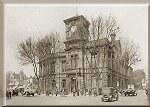 |
 |
Return to
Industrial Development
|
Proceed to
1800
onward |










